CHEVROLET MONTE CARLO 2003 6.G Owners Manual
Manufacturer: CHEVROLET, Model Year: 2003, Model line: MONTE CARLO, Model: CHEVROLET MONTE CARLO 2003 6.GPages: 394, PDF Size: 2.73 MB
Page 321 of 394
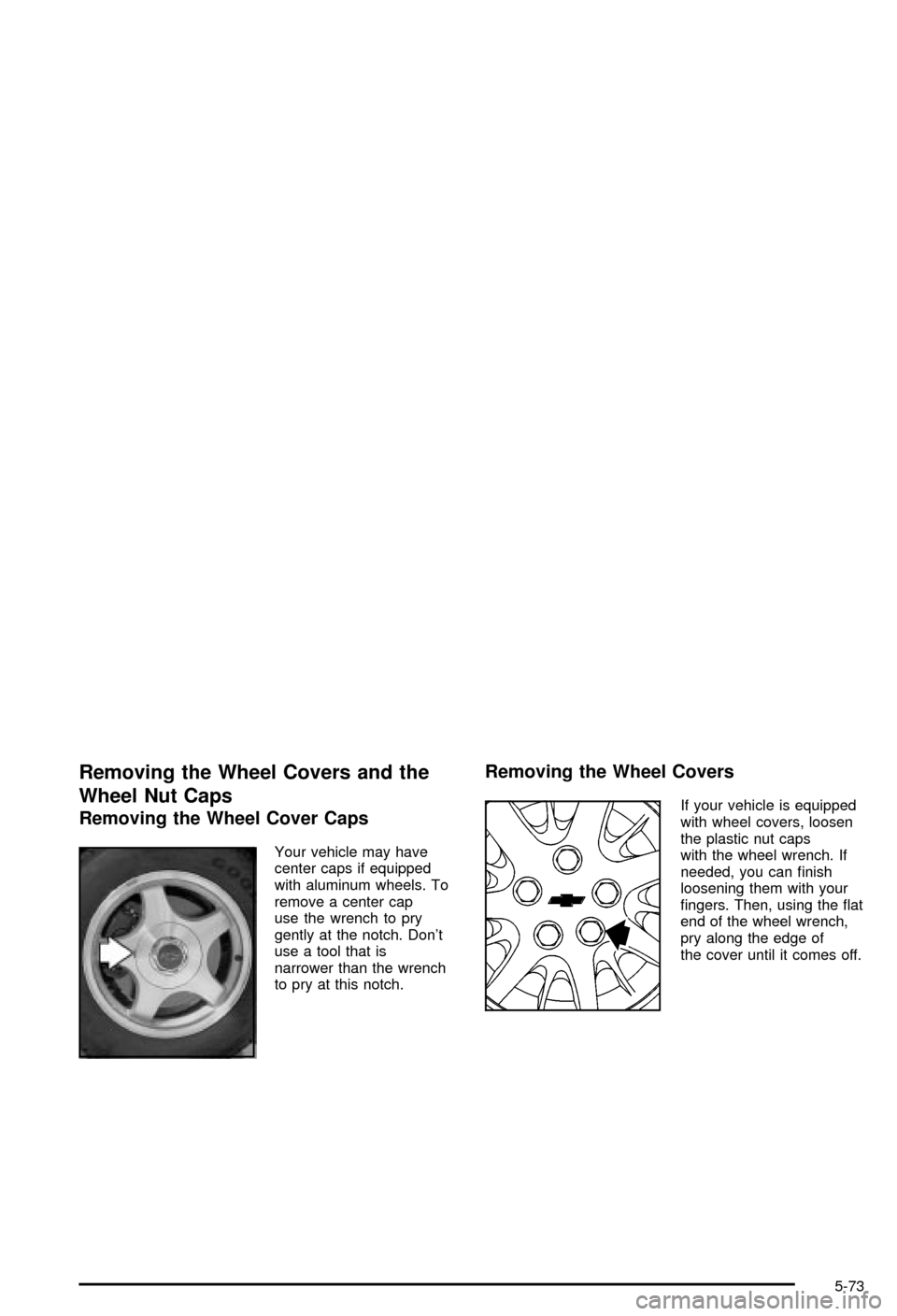
Removing the Wheel Covers and the
Wheel Nut Caps
Removing the Wheel Cover Caps
Your vehicle may have
center caps if equipped
with aluminum wheels. To
remove a center cap
use the wrench to pry
gently at the notch. Don't
use a tool that is
narrower than the wrench
to pry at this notch.
Removing the Wheel Covers
If your vehicle is equipped
with wheel covers, loosen
the plastic nut caps
with the wheel wrench. If
needed, you can ®nish
loosening them with your
®ngers. Then, using the ¯at
end of the wheel wrench,
pry along the edge of
the cover until it comes off.
5-73
Page 322 of 394
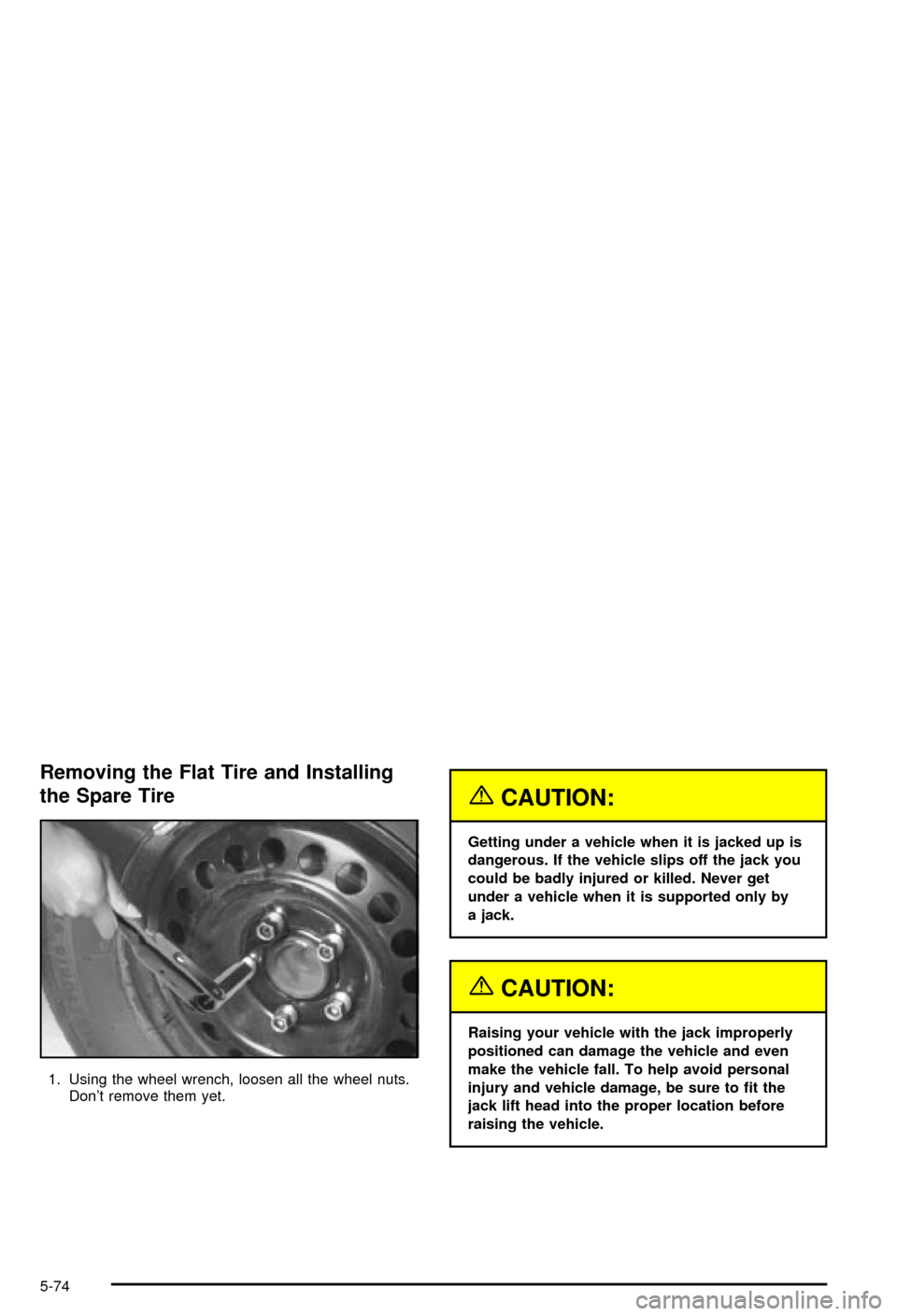
Removing the Flat Tire and Installing
the Spare Tire
1. Using the wheel wrench, loosen all the wheel nuts.
Don't remove them yet.
{CAUTION:
Getting under a vehicle when it is jacked up is
dangerous. If the vehicle slips off the jack you
could be badly injured or killed. Never get
under a vehicle when it is supported only by
a jack.
{CAUTION:
Raising your vehicle with the jack improperly
positioned can damage the vehicle and even
make the vehicle fall. To help avoid personal
injury and vehicle damage, be sure to ®t the
jack lift head into the proper location before
raising the vehicle.
5-74
Page 323 of 394

The diagram shows you where you should place
your jack to change a front tire. Use the bolts (A) as
a guide when positioning the jack lift head (C)
near the rear edge of the front wheel opening (B).
For jacking at the vehicle's front location, put jack lift
head about 7.5 inches (19 cm) from the rear edge
of the front wheel opening in the cutout of the rocker
panel molding.The diagram shows you where to place your jack to
change a rear tire. Use the notch (B) as a guide
when positioning the jack lift head (A) near the front
edge of the rear wheel opening (C).
For jacking at the vehicle's rear location, put the
jack lift head about 4 inches (10 cm) from the front
edge of the rear wheel opening in the cutout of
the rocker panel molding.
Put the compact spare tire near you. Jack placement for a front tire
Jack placement for a rear tire
5-75
Page 324 of 394
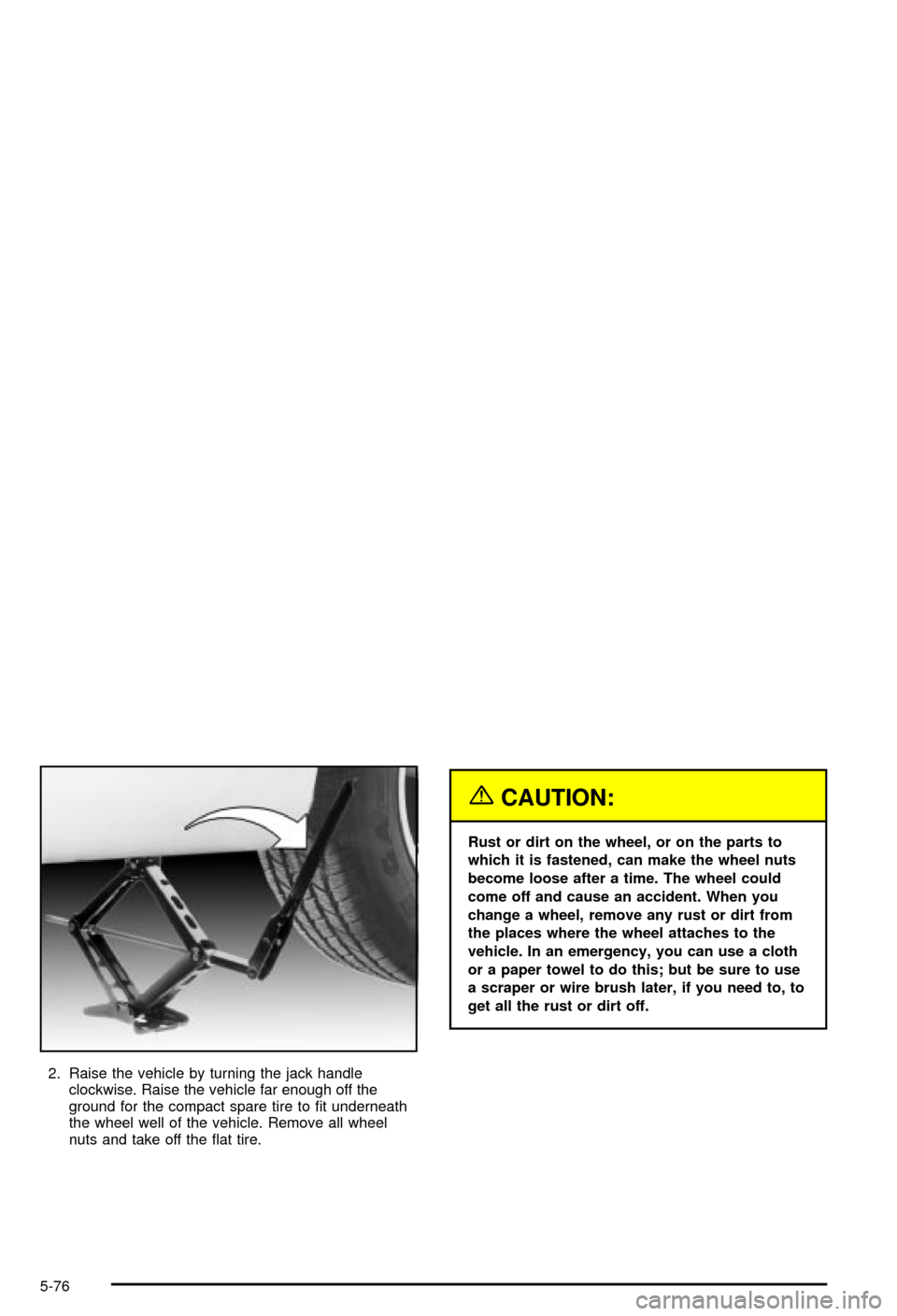
2. Raise the vehicle by turning the jack handle
clockwise. Raise the vehicle far enough off the
ground for the compact spare tire to ®t underneath
the wheel well of the vehicle. Remove all wheel
nuts and take off the ¯at tire.
{CAUTION:
Rust or dirt on the wheel, or on the parts to
which it is fastened, can make the wheel nuts
become loose after a time. The wheel could
come off and cause an accident. When you
change a wheel, remove any rust or dirt from
the places where the wheel attaches to the
vehicle. In an emergency, you can use a cloth
or a paper towel to do this; but be sure to use
a scraper or wire brush later, if you need to, to
get all the rust or dirt off.
5-76
Page 325 of 394
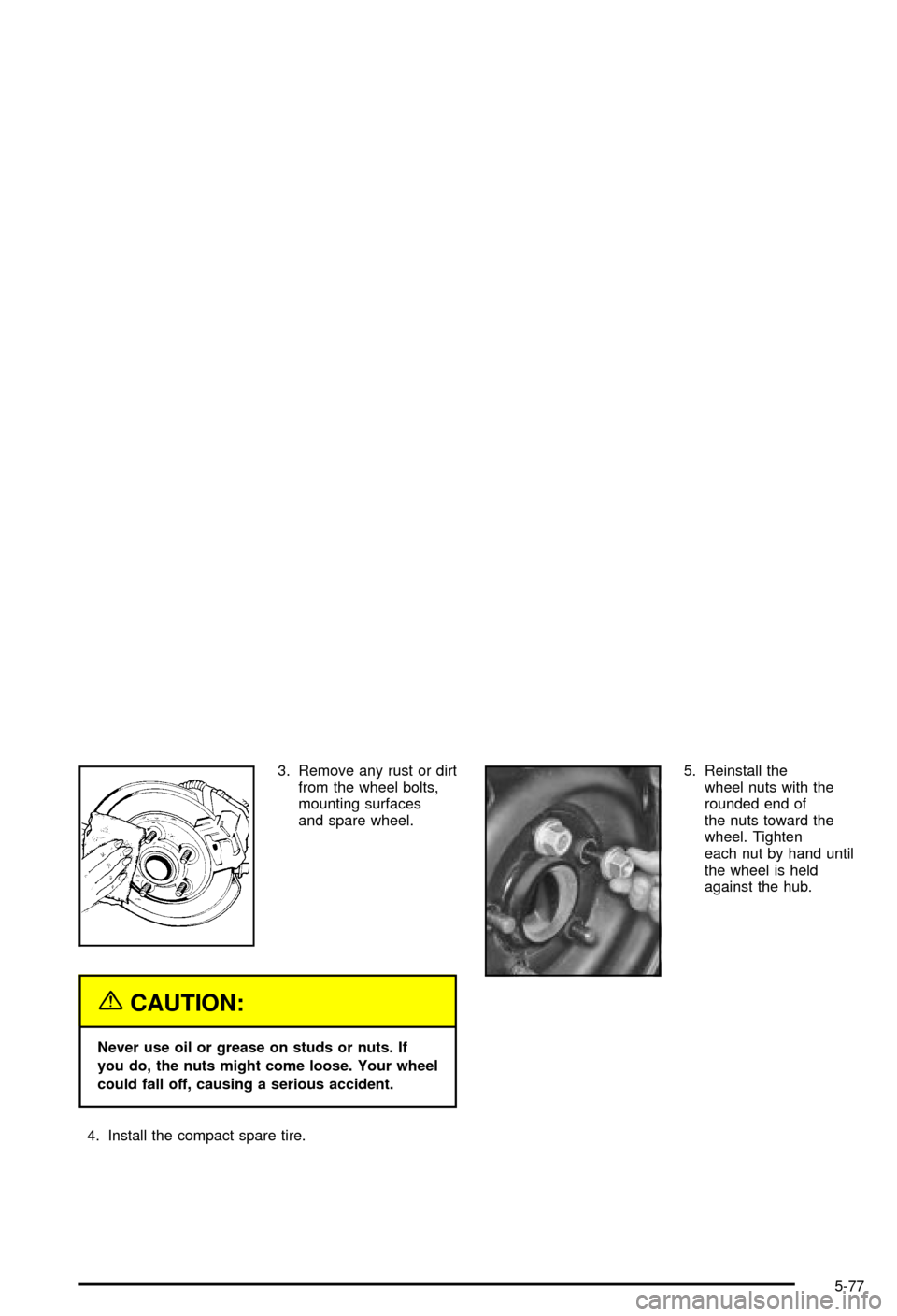
3. Remove any rust or dirt
from the wheel bolts,
mounting surfaces
and spare wheel.
{CAUTION:
Never use oil or grease on studs or nuts. If
you do, the nuts might come loose. Your wheel
could fall off, causing a serious accident.
4. Install the compact spare tire.5. Reinstall the
wheel nuts with the
rounded end of
the nuts toward the
wheel. Tighten
each nut by hand until
the wheel is held
against the hub.
5-77
Page 326 of 394
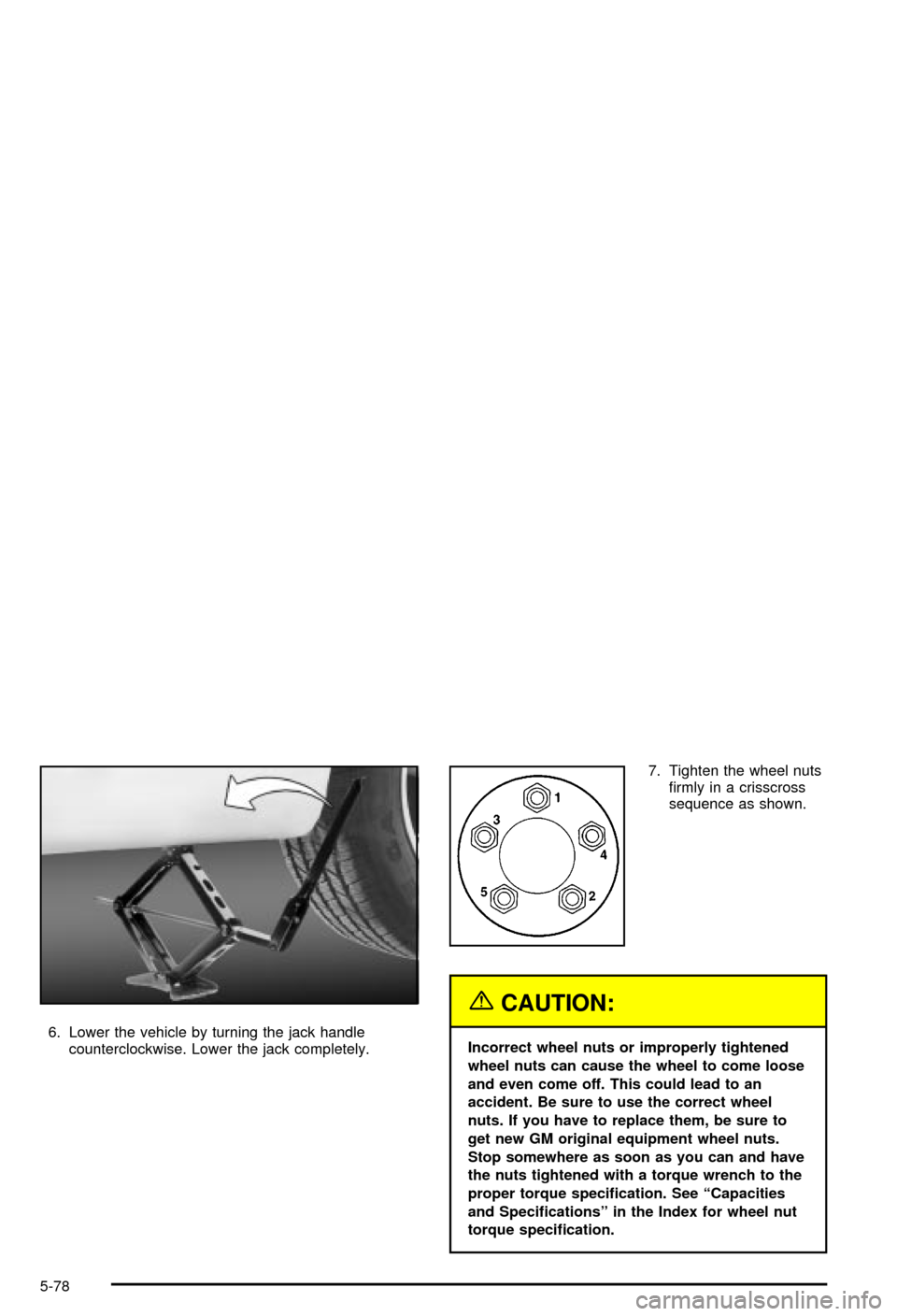
6. Lower the vehicle by turning the jack handle
counterclockwise. Lower the jack completely.7. Tighten the wheel nuts
®rmly in a crisscross
sequence as shown.
{CAUTION:
Incorrect wheel nuts or improperly tightened
wheel nuts can cause the wheel to come loose
and even come off. This could lead to an
accident. Be sure to use the correct wheel
nuts. If you have to replace them, be sure to
get new GM original equipment wheel nuts.
Stop somewhere as soon as you can and have
the nuts tightened with a torque wrench to the
proper torque speci®cation. See ªCapacities
and Speci®cationsº in the Index for wheel nut
torque speci®cation.
5-78
Page 327 of 394
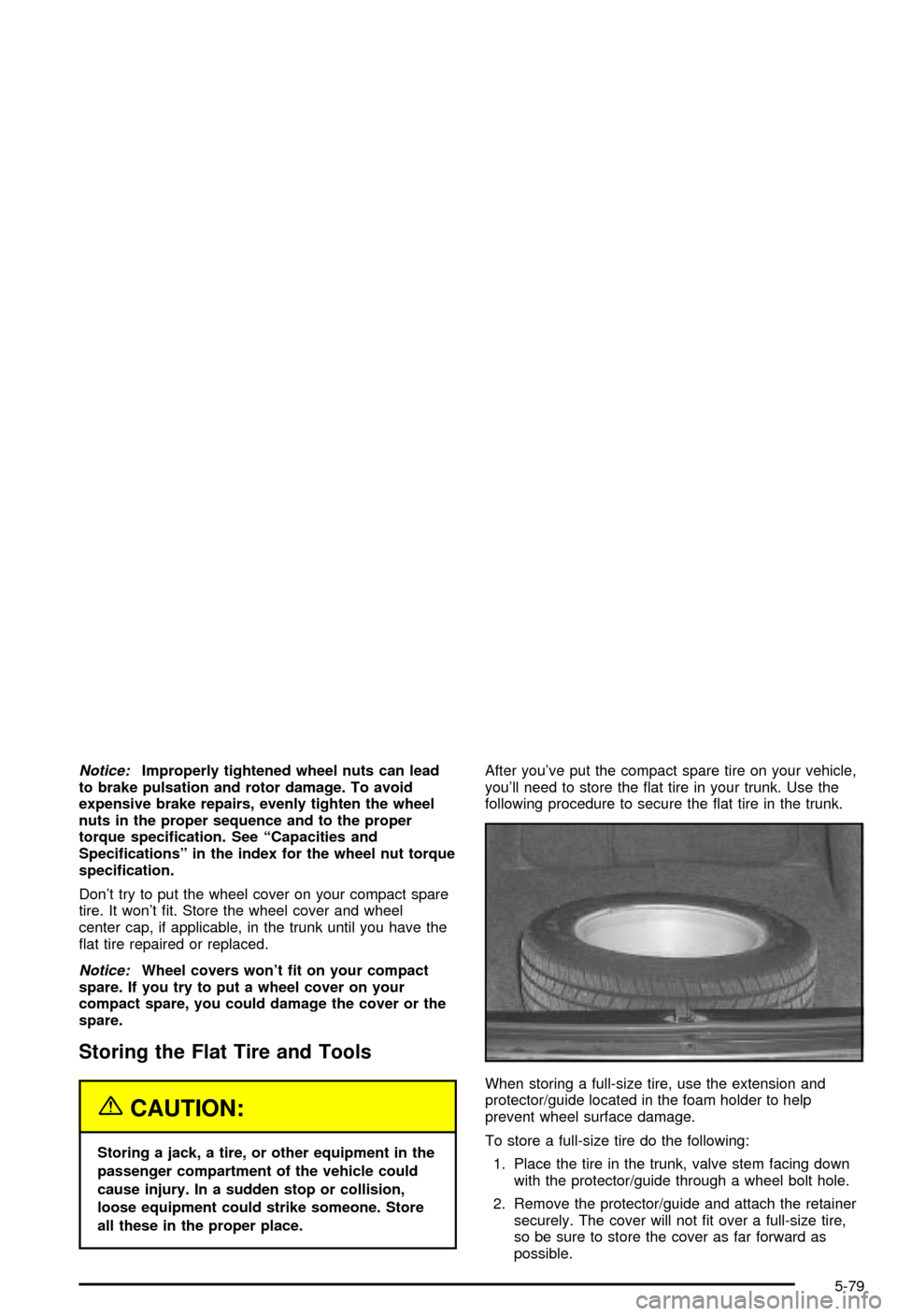
Notice:Improperly tightened wheel nuts can lead
to brake pulsation and rotor damage. To avoid
expensive brake repairs, evenly tighten the wheel
nuts in the proper sequence and to the proper
torque speci®cation. See ªCapacities and
Speci®cationsº in the index for the wheel nut torque
speci®cation.
Don't try to put the wheel cover on your compact spare
tire. It won't ®t. Store the wheel cover and wheel
center cap, if applicable, in the trunk until you have the
¯at tire repaired or replaced.
Notice:Wheel covers won't ®t on your compact
spare. If you try to put a wheel cover on your
compact spare, you could damage the cover or the
spare.
Storing the Flat Tire and Tools
{CAUTION:
Storing a jack, a tire, or other equipment in the
passenger compartment of the vehicle could
cause injury. In a sudden stop or collision,
loose equipment could strike someone. Store
all these in the proper place.After you've put the compact spare tire on your vehicle,
you'll need to store the ¯at tire in your trunk. Use the
following procedure to secure the ¯at tire in the trunk.
When storing a full-size tire, use the extension and
protector/guide located in the foam holder to help
prevent wheel surface damage.
To store a full-size tire do the following:
1. Place the tire in the trunk, valve stem facing down
with the protector/guide through a wheel bolt hole.
2. Remove the protector/guide and attach the retainer
securely. The cover will not ®t over a full-size tire,
so be sure to store the cover as far forward as
possible.
5-79
Page 328 of 394
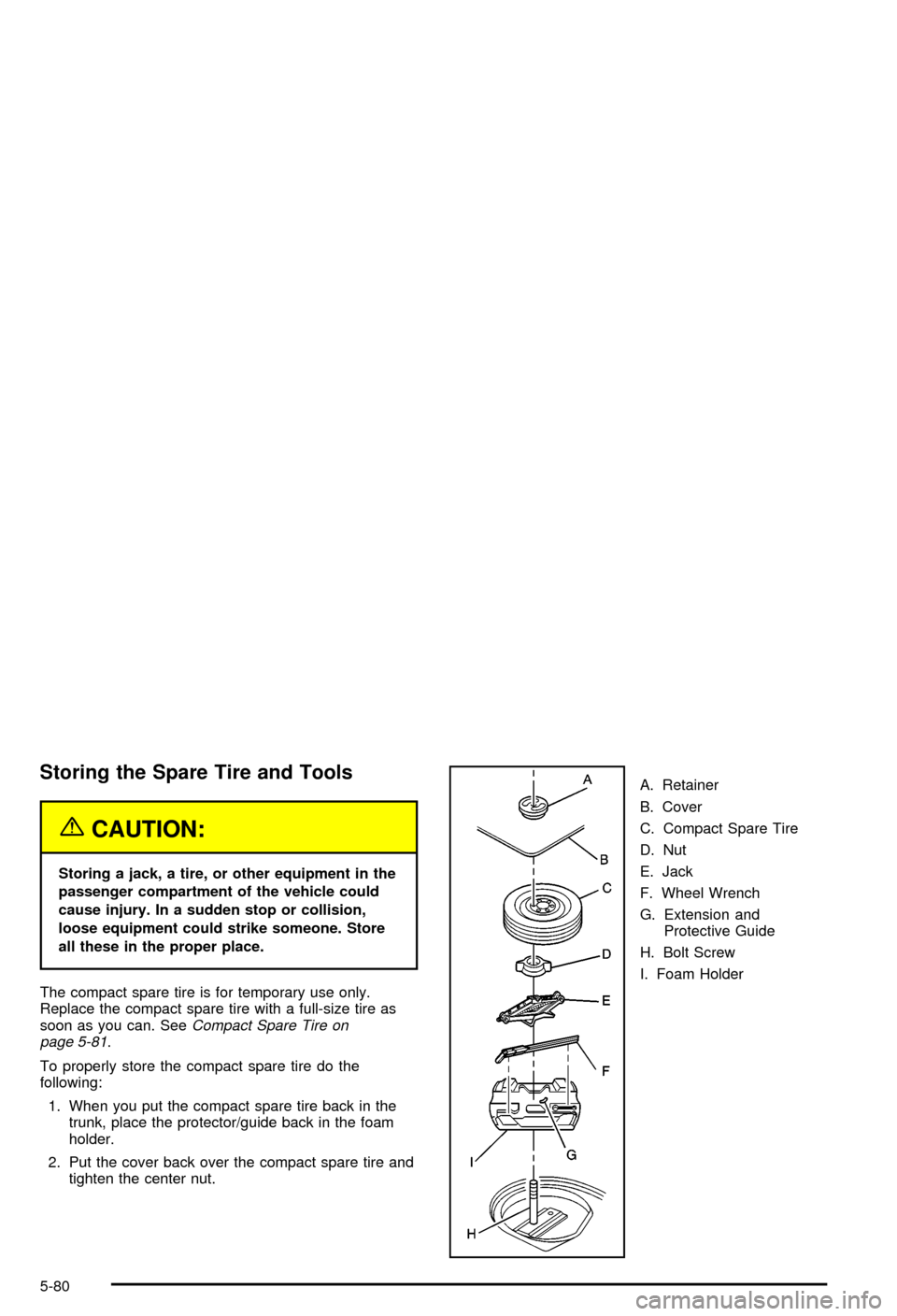
Storing the Spare Tire and Tools
{CAUTION:
Storing a jack, a tire, or other equipment in the
passenger compartment of the vehicle could
cause injury. In a sudden stop or collision,
loose equipment could strike someone. Store
all these in the proper place.
The compact spare tire is for temporary use only.
Replace the compact spare tire with a full-size tire as
soon as you can. See
Compact Spare Tire on
page 5-81.
To properly store the compact spare tire do the
following:
1. When you put the compact spare tire back in the
trunk, place the protector/guide back in the foam
holder.
2. Put the cover back over the compact spare tire and
tighten the center nut.A. Retainer
B. Cover
C. Compact Spare Tire
D. Nut
E. Jack
F. Wheel Wrench
G. Extension and
Protective Guide
H. Bolt Screw
I. Foam Holder
5-80
Page 329 of 394

Compact Spare Tire
Although the compact spare tire was fully in¯ated when
your vehicle was new, it can lose air after a time.
Check the in¯ation pressure regularly. It should be
60 psi (420 kPa).
After installing the compact spare on your vehicle, you
should stop as soon as possible and make sure
your spare tire is correctly in¯ated. The compact spare
is made to perform well at speeds up to 65 mph
(105 km/h) for distances up to 3,000 miles (5 000 km),
so you can ®nish your trip and have your full-size
tire repaired or replaced where you want. You must
calibrate the tire in¯ation monitor system after installing
or removing the compact spare. See
Tire Pressure
Monitor System on page 5-61. The system may not work
correctly when the compact spare is installed on the
vehicle. Of course, it's best to replace your spare with a
full-size tire as soon as you can. Your spare will last
longer and be in good shape in case you need it again.
Notice:When the compact spare is installed, don't
take your vehicle through an automatic car wash
with guide rails. The compact spare can get caught
on the rails. That can damage the tire and wheel,
and maybe other parts of your vehicle.
Don't use your compact spare on other vehicles.
And don't mix your compact spare tire or wheel with
other wheels or tires. They won't ®t. Keep your spare tire
and its wheel together.
Notice:Tire chains won't ®t your compact spare.
Using them can damage your vehicle and can
damage the chains too. Don't use tire chains on
your compact spare.
5-81
Page 330 of 394

Appearance Care
Remember, cleaning products can be hazardous. Some
are toxic. Others can burst into ¯ames if you strike a
match or get them on a hot part of the vehicle. Some are
dangerous if you breathe their fumes in a closed
space. When you use anything from a container to clean
your vehicle, be sure to follow the manufacturer's
warnings and instructions. And always open your doors
or windows when you are cleaning the inside.
Never use these to clean your vehicle:
·Gasoline
·Benzene
·Naphtha
·Carbon Tetrachloride
·Acetone
·Paint Thinner
·Turpentine
·Lacquer Thinner
·Nail Polish RemoverThey can all be hazardous Ð some more than
others Ð and they can all damage your vehicle, too.
Do not use any of these unless this manual says
you can. In many uses, these will damage your vehicle:
·Alcohol
·Laundry Soap
·Bleach
·Reducing Agents
Cleaning the Inside of Your Vehicle
Use a vacuum cleaner often to get rid of dust and
loose dirt. Wipe vinyl, leather, plastic and painted
surfaces with a clean, damp cloth.
Cleaning Fabric/Carpet
Your dealer has cleaners for the cleaning of fabric
and carpet. They will clean normal spots and stains
very well.
You can get GM-approved cleaning products from your
dealer. See
Vehicle Care/Appearance Materials on
page 5-89.
5-82